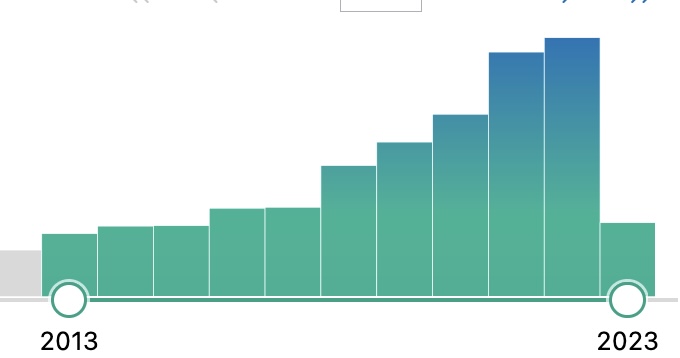
How is Therapeutic Virtual Reality Progressing in terms of Clinical Trials and Publications?
Lots to report. An analysis by Denise Silber, VRforHealth
While the majority of professionals and patients are not yet informed about the therapeutic benefits of virtual reality, the number of clinical trials and publications is rising quickly, thanks to the collaborations between virtual reality solutions start-ups and clinical research centers. They are a necessary first step in the adoption process of a new technology and a growing number of centers are using virtual reality beyond the trials. This article reports on the geography of clinical trials, their number, the main use cases being studies, and provides examples of systematic reviews and meta-analyses.
Europe and the United States are leading the way with 60% of the 2014 clinical trials listed on ClinicalTrials.gov, as of April 19th, 2023. The total number of trials has approximately doubled in the past 3 years. The trials concern 882 conditions as defined by ClinicalTrials.gov. As to publications, in the past year, more than 40 meta-analyses and review articles were published, according to Medline.
The Geography of Virtual Reality Clinical Trials
The following map was extracted from the ClinicalTrials.gov data base on April 18th, 2023 under the keyword “virtual reality”. The numbers represent the clinical trials using virtual reality, and registered on the ClinicalTrials.gov website.

Europe represents 31% of the total, with 629 trials listed. The United States represents 29% of the world total with 590 trials listed. France leads in Europe with 175 trials or 28% of the European total.
In France, 175 trials are spread all over the country, enhancing the awareness of professionals in different regions. France is followed by Italy and Spain, with 96 and 84 trials respectively, representing around 15% of the European total. Switzerland and Belgium follow with 54 and 50 trials respectively, confirming that total population size is not an obstacle. Switzerland and Belgium are followed by the UK with 42 trials, the Netherlands with 32 trials, and Germany with 28.

In the United States, The distribution amongst the 50 states is uneven. California, in the lead with 110 trials (or approximately as many trials as in Canada), is followed by New York State with 64 trials and Texas with 45. These 3 states account for 37% of the total number of American trials. 13 states have between only 1 and 3 trials and 8 states have none.

Note: Veterans Medical Centers account for approximately 20 clinical trials in the US.
How does the research break down in terms of use cases?
We examined the keywords appearing in the trials, in order to determine their relative frequency. While there is of course overlap amongst the following keywords, the figures confirm that the effect of virtual reality on pain and anxiety, and its use in rehabilitation are the main therapeutic characteristics being studied and that both “rehab post stroke” and use in cancer patients for anxiety and pain are leading use cases.
Pain is present in 458 trial descriptions.
Anxiety is present in 390 trial descriptions.
Rehabilitation is present in 327 trial descriptions.
Stroke is present in 224 trial descriptions.
Oncology / cancer appear in 113 trial descriptions.
Mental health appears in 33 trial descriptions.
Childbirth appears in 20 trial descriptions.
Addiction appears in 14 trial descriptions.
Palliative care appears in 11 trial descriptions.
Virtual Reality Publication Highlights
Since 2013, 2369 articles published on Medline include the terms “virtual reality” and “therapy” or therapeutic in their title and abstract. There were 116 in 2013 and 510 in 2022.

Systematic reviews and meta-analysis of Therapeutic VR
As we know, systematic reviews and meta-analyses often conclude that existing research is insufficient. Nonetheless, we note that there are sufficient publications regarding virtual reality clinical research to enable a growing number of systematic reviews and meta-analyses (40+ in the past year) to be executed, and the results are promising. Here are a few examples of these publications.
Jin M, Pei J, Bai Z, Zhang J, He T, Xu X, Zhu F, Yu D, Zhang Z. Effects of virtual reality in improving upper extremity function after stroke: A systematic review and meta-analysis of randomized controlled trials. Clin Rehabil. 2022 May;36(5):573-596. doi: 10.1177/02692155211066534. Epub 2021 Dec 13. PMID: 34898298.
“Conclusion: Virtual reality is recommended for improving motor impairment and activities of daily living after stroke and is favorable to patients with moderate to severe paresis. An immersive design could produce greater improvement.”
Castellano-Aguilera A, Biviá-Roig G, Cuenca-Martínez F, Suso-Martí L, Calatayud J, Blanco-Díaz M, Casaña J. Effectiveness of Virtual Reality on Balance and Risk of Falls in People with Multiple Sclerosis: A Systematic Review and Meta-Analysis. Int J Environ Res Public Health. 2022 Oct 30;19(21):14192. doi: 10.3390/ijerph192114192. PMID: 36361069; PMCID: PMC9656689.
“VR-based treatments are more effective than non-intervention in improving balance and fall risk in people with MS, with a very low certainty of evidence. In addition, they also show to be more effective than conventional rehabilitation, with a very low certainty of evidence.”
Tas FQ, van Eijk CAM, Staals LM, Legerstee JS, Dierckx B. Virtual reality in pediatrics, effects on pain and anxiety: A systematic review and meta-analysis update. Paediatr Anaesth. 2022 Dec;32(12):1292-1304. doi: 10.1111/pan.14546. Epub 2022 Sep 1. PMID: 35993398; PMCID: PMC9804813.
“The current updated systematic review and meta-analysis indicates that virtual reality is a useful tool to reduce pain and anxiety in pediatric patients undergoing a range of medical procedures as it significantly decreases pain and anxiety outcomes when compared to care as usual.”
Czech O, Wrzeciono A, Batalík L, Szczepańska-Gieracha J, Malicka I, Rutkowski S. Virtual reality intervention as a support method during wound care and rehabilitation after burns: A systematic review and meta-analysis. Complement Ther Med. 2022 Sep;68:102837. doi: 10.1016/j.ctim.2022.102837. Epub 2022 Apr 29. PMID: 35490982.
“Conclusions: VR seems to be an effective therapeutic support in burn wound care procedures for reducing pain. However, this systematic review and meta-analysis highlights the need for more research into the use of VR as a distraction method. Studies on larger groups using similar conditions can provide unequivocal evidence of the effectiveness of VR and enable the inclusion of such intervention in standard medical procedures.“
Mo J, Vickerstaff V, Minton O, Tavabie S, Taubert M, Stone P, White N. How effective is virtual reality technology in palliative care? A systematic review and meta-analysis. Palliat Med. 2022 Jul;36(7):1047-1058. doi: 10.1177/02692163221099584. Epub 2022 May 30. PMID: 35635018; PMCID: PMC9248003.
“Virtual reality in palliative care is feasible and acceptable.However, limited sample sizes and very low-quality studies mean that the efficacy of virtual reality needs further research.“
Conclusions
The impressive number of clinical trials and publications attest to the growing interest in the therapeutic uses of virtual reality. Europe and the United States are leading the way in research. There are many promising use cases, regarding pain, anxiety, and rehabilitation.
How can we further accelerate the availability of virtual reality for the benefit of patients? We hope that you will join us in this effort. Check out the VRforHealth website for our videos, the blog articles, the VRforHealth Directory.
This article was originally published on vrforhealth
